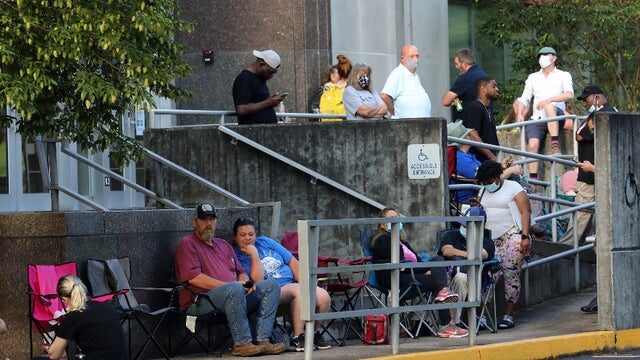
© Getty
New weekly claims for unemployment benefits stayed flat last week when adjusted for seasonal factors, but rose by more than 20,000 on an unadjusted basis, the Labor Department reported Thursday.
In the week ending Sept. 5, the number of seasonally adjusted initial claims for unemployment insurance totaled 884,000, unchanged from the previous week's revised level of applications.
Without adjustments for seasonal factors, claims rose 857,148 in the week ending Sept. 5, a 2.4 percent increase from the previous week's 837,000 claims.
Claims for Pandemic Unemployment Assistance, a program meant to cover workers excluded from traditional jobless benefits, also rose to 838,916 last week, an increase of roughly 91,000 applications from the previous week.Taken together, the new data on jobless claims is a troubling sign for a U.S. economy
still suffering from high levels of unemployment and staggeringly high unemployment applications more than five months after the onset of the coronavirus recession. Weekly jobless claims totaled just 208,000 at the same time in 2019 but have remained above 880,000 for more than 25 consecutive weeks.
Some economists attribute the lack of decline in unemployment claims to the July 31 expiration of enhanced jobless benefits and other fiscal aid that helped keep consumer demand high, thereby helping businesses stay afloat.
"What is clear from the claims data is that the
expiration of unemployment benefits is if anything sapping positive momentum in the labor market, not boosting it. The problem here is labor DEMAND not labor supply. We are supporting demand less so we get less hiring," tweeted Julia Coronado, a former Federal Reserve economist.
While the unemployment rate dropped from 10.2 percent in July to 8.4 percent in August, the
number of people receiving some form of jobless benefits increased by 300,000 in the week ending Aug. 22."Through the week of August 22, there were 29.6 million individuals receiving some form of unemployment benefits," wrote Joe Brusuelas, chief economist at tax and audit firm RSM.
"This is not an encouraging evolution of the data."
The new data comes amid a
continuing stalemate between Democrats and Republicans over another round of coronavirus relief and fiscal aid. While both parties have acknowledged the needs for more economic support, they have been unable to overcome differences over the size of a potential package and how much aid should be included for struggling state and local governments.
The Senate is set to
vote Thursday on a $500 billion
relief package that Democratic leaders have already declared dead on arrival. The bill is not expected to get the 60 votes needed to pass the Senate and head to the House, where it would likely die anyway, but Republican leaders are eyeing the vote as a way to project unity and cover vulnerable incumbents ahead of the November elections.

Comment: